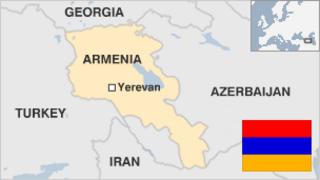Armenia country profile
A landlocked country with Turkey to the west, Georgia to the north, and Azerbaijan to the east, Armenia boasts a history longer than most European countries.
After independence from the Soviet Union in 1991, Armenia quickly became drawn into a bloody conflict with Azerbaijan over the mainly Armenian Nagorno-Karabakh region.
One of the earliest Christian civilisations, Armenia’s first churches were founded in the fourth century. In later centuries, it frequently oscillated between Byzantine, Persian, Mongol or Turkish control, as well as periods of independence.
FACTS
The Republic of Armenia
Capital: Yerevan
Population 3.1m
Area 29,743 sq km (11,484 sq miles)
Major languages Armenian, Russian
Major religion Christianity
Life expectancy 71 years (men), 77 years (women)
Main exports Diamonds, machinery, foodstuffs
LEADERS
Prime minister-elect: Nikol Pashinyan
Opposition leader Nikol Pashinyan was elected as prime minister by parliament in May 2018 after he spearheaded weeks of mass protests against the ruling party, transforming the country’s political landscape.
He had piled pressure on the ruling Republican Party through an unprecedented campaign of civil disobedience, leading to the shock resignation of veteran leader Serzh Sargsyan, a week after he shifted to the newly-empowered role of prime minister after serving for 10 years as president.
He must reckon with a parliament where the Republican Party holds a majority of seats and is sceptical about his revolution.
Mr Pashinyan promised to maintain Armenia’s strategic alliance with Russia, whose president, Vladimir Putin, sent his congratulations.
President: Armen Sargsyan
Armen Sargsyan was elected president in March 2018, when the country moved from a presidential system of government to a parliamentary one.
He briefly served as prime minister from November 1996 to March 1997 between stints as ambassador to the UK and other diplomatic posts in Europe.
Voters in a 2015 referendum backed constitutional changes reducing the powers of the president in favour of the premiership, which critics saw as a ruse to allow outgoing president Serzh Sargsyan to continue to rule as prime minister.
Serzh Sargsyan duly became prime minister on the expiry of his second term as president in April 2018, but sparked the largest street protests Armenia has seen for years. He resigned after several days of unrest.
MEDIA
Television is Armenia’s dominant medium. Some 25 private stations operate alongside two public networks. The main Russian networks are widely available.
Few Armenians rely on newspapers as their main news source. Print runs are small – usually a few thousand copies – and most titles are owned by wealthy individuals or political parties.
A media law prohibits censorship. However, libel and defamation can be punished by prison terms and journalists have been sentenced under relevant laws.
TIMELINE
Some key events in Armenia’s history:
1915 – 1917 – Between 600,000 and 1.5 million Armenians are massacred or deported from their homeland in Anatolia to present-day Syria. Armenia considers the killings genocide, a charge Turkey does not accept.
1918 – Independent Armenia emerges from defeat of Ottoman Empire in World War I.
1922 – Armenia is incorporated into the Soviet Union.
1989 – Conflict over Nagorno-Karabakh begins. In 1994 a Russian-brokered ceasefire but no peace deal is reached and intermittent fighting continues.
1991 – Armenia secedes from the Soviet Union.
2009 – Armenia and Turkey agree on a provisional roadmap for normalising diplomatic ties, but subsequently fail to ratify the deal.
2015 – Armenia officially joins the Russian-led Eurasian Customs Union, having decided against signing a EU Association Agreement.
Source: Read Full Article



